|
MODELING ISSUES .......... |
A Pilots Tale
by Bob Dietrich, East Penn Traction Club
Most American interurban cars sported a pilot up front for clearing the way. Some Ohio interurban pilots were large enough to move a buffalo off the tracks, although there were few bison in Ohio.

But the pilot on a Pittsburgh Railways (PRCo) interurban (I bet you didn’t know PRCo had interurban cars did you?) seemed just good enough to possibly scatter rodents.

In 1909, PRCo ordered 20 new cars for their interurban lines. The 3600 series Kuhlman-built single end interurban cars had railroad style seating and were typical heavy 73,000 lb, high wooden cars with a smoking compartment, toilet and ice water dispenser. Passengers used the rear door and the large front door was used for handling freight and express. These 52 ft long cars were powered by four Westinghouse 303 100 hp motors with Type M controllers. they were durable and remained in service until 1928 when they were replaced with fifteen lightweight 3800 series cars, built by Saint Louis Car Co. One of these cars, car 3619, is shown on College Street in Washington, PA:
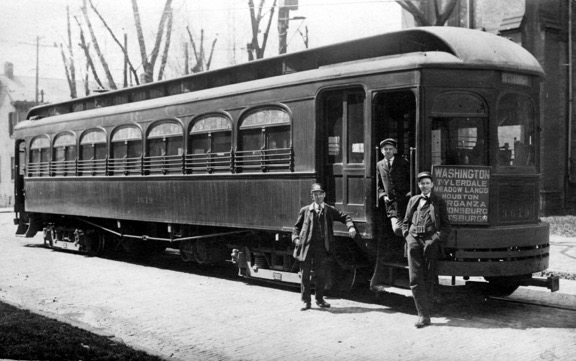
A PRCo 3600 series pilot is the object of this experiment. I’m building a model of a 3600 series car in HO and it needed a pilot. So I searched for available pilots and found:
 and and  and and 
Well, you got the picture, there is not a very good selection. After smashing and twisting on some of these commercial products I came to the conclusion that, if I wanted accuracy (or close to it), I had to scratch build one. This started me on a quest for soldering perfection. My first decision is the only one I didn’t change during the process – .010 x .030 brass with .040 spacing should be used for the “vertical” bars. The prototype had 13 bars and 13 spaced bars came to what looks like a reasonable width for the pilot. Did I mention that there are no plans? The top support is curved to match the curve of the car’s bumper and the bottom support is pointed with straight sides. On all but one attempts I cut the bars to about an inch long to give me something to hold on to.
Step 1 – I used .040” styrene spacers and held the bars in place with scotch tape. I wasted a lot of tape because I need a piece of tape for every 2 or 3 bars. It was like miniature pick-up-sticks. Once I got everything straight I soldered the top support, a curved 3/64 brass angle. Then I flipped it over and soldered the bottom support to the bars. Now the fun began – the idea was to grab the top and bottom bars and push them in opposite directions. I figured this would work since the pilot is not very tall but the assembled unit is stronger than I expected and all I managed was to bend a few bars incorrectly. I didn’t waste much time in this before giving up and going to version 2.
Step 2 – Two things were different on this step. First, I annealed the bars so they would bend easier. Second, I used a piece of wood clapboard for the spacer. I could get all 13 bars to lay still until I held them with the tape. The rest of this operation was the same as #1 except the pushing went easier but was still not perfect. The bars gave OK but I couldn't’t get a good grip on the top and bottom supports so the end result was somewhat twisted. I couldn't’t get the pilot straight on the car, no matter how I bent it to support it just sat crooked. On to Step 3.
Step 3 – This is where I went "radical" by trying to solder individual short pieces of bar material to the supports that were held in place. To accomplish this I cut a piece of 1/16” basswood to the correct curve of the top support and another piece of thicker wood to match the angle of the bottom support. I positioned these to match the distance of the support. Then I taped and spiked the support pieces to this fixture. I also decided that using the angle brass for the supports was not worth the effort since they twisted when curved and very little is seen of them, so I went to .032 brass wire instead. I was able to solder the individual bars to the supports but with great difficulty. I had to get them straight and spaced correctly by eye – I failed at both. What killed this version is I left out one bar so the thing is not symmetrical. But so what, who would notice? Just me!
Step 4 – Finally success, using a combination of efforts from above. I used the longer bars spaced on the clapboard and taped to the rounded basswood. To these I soldered the top support. I turned it over positioning the support properly on the rounded basswood but with the bars below the support pressed against the basswood. The lower support was taped in place and, here is the difference, the individual bars were bent down and soldered to the lower support. Everything where it should be without undo effort or failure.
All versions are mounted to the cars by bending the top support up and putting it through holes in the wood floor. I can use the pilots from attempts 2 and 3 on other, ”lesser”, cars but I wanted my best effort on this one.

To avoid soldering, styrene could have been substituted for brass but it would most likely not be as strong. Bending the bars would require a soaking in styrene bonding agent and careful work. I would have most likely cut the supports from a sheet stock instead of trying the curve a styrene strip.
|
Commuter Rail / Light Rail / Modern Streetcar News!
***
by Edward B. Havens
Passengers riding the new 2.2-mile modern streetcar line at Kansas City now have a method at each station to tell how soon the next car will arrive. Kansas City Business Journal reported July 12 that interactive, computerized maps have been installed at station kiosks. The real-time tracking function for each of the three streetcars used in peak service also is to be transferred to smart phone applications for iPhone and Android users. The Streetcar Authority worked with a media company to collect data from GPS (Global Positioning System) units on each car. There are four in the fleet but one is reserved as a spare.
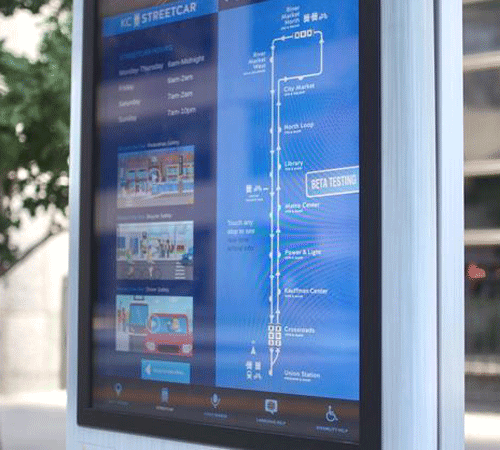
A 606-page draft environmental report for the Los Angeles downtown modern streetcar project was released in advance of a public meeting July 12 to discuss the project, which still has no construction funding, the Los Angeles Downtown News reported. The study offered route options but some might be ruled out because project organizers want to keep the total cost below $250 million. Six streetcars would be needed to provide seven-minute headways during peak hours.
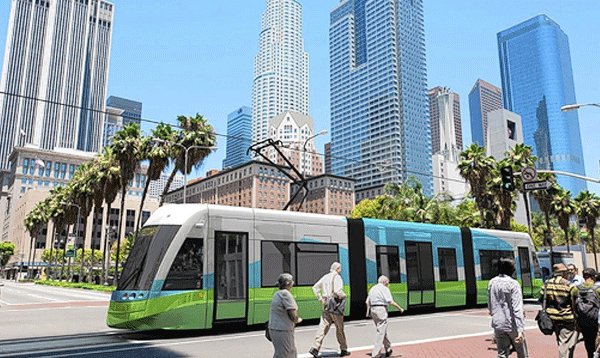
New Siemens LRVs built at the company's Sacramento (Florin), California, factory entered service July 5 on the Calgary Transit System network in Alberta province in western Canada, the International Railway Journal reported. The agency signed a contract in 2013 for 63 high-floor LRVs costing USD $154 million. Each is decorated in a special livery patterned after a hockey mask because sports on the ice is important at Calgary. The order is due to be completed by Siemens next year.
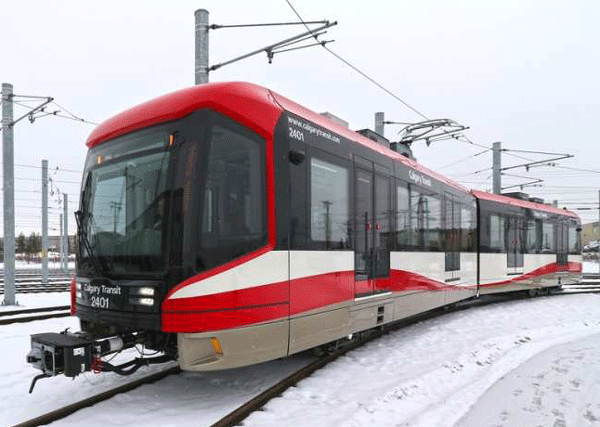
The Kazahk TV web site reported July 11 that a China-based consortium is building a USD $56 million, 13.9-mile light rail at Astana, the capital city of Kazakhstan in central Asia, to link the new railway station and the city's airport. Service is expected to debut in 2018. The line will use both on-street track and reserved right of way.
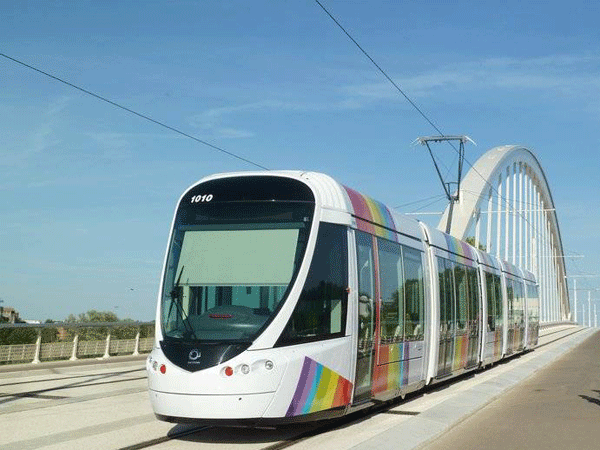
| Brookville Equipment Corp. of western Pennsylvania shipped a third "Liberty" model dual-mode streetcar with pantographs and battery power to Dallas Area Rapid Transit [DART], the progressive railroading.com site reported July 11. DART exercised a contract option in July 2015 for two additional cars, raising the total to four for use on the downtown Dallas to Oak Cliff car line. That will support the extension of the line to Bishop Arts District. The battery power is for the wire free run over historic Houston Street Viaduct bridging the Trinity River. |
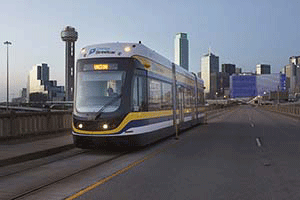 |
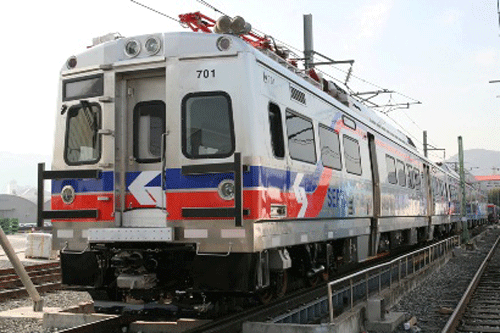 |
Southeastern Pennsylvania Transportation Authority [SEPTA] sidelined all 120 of its Hyundai Rotem electric multiple-unit coaches after suspension problems were discovered July 1, Philadelphia media outlets reported. Cracks were found in the equalizer beams in the truck assemblies. With one-third of its Regional Rail fleet out of action, SEPTA leased locomotives and coaches from Amtrak and NJ Transit and coaches from Maryland MARC. The cost to lease equipment will top $257,000 per month and regular service is not expected to return until after Labor Day, The Philadelphia Inquirer reported July 11. In the interim, SEPTA has put into effect a modified weekday schedule on 12 routes with the Cynwyd shuttle replaced by buses. Rail service now is handled by GE Silverliner IV cars built in 1971 augmented by the leased rolling stock.
|
The East Troy heritage electric railroad in Wisconsin sustained damage to an interurban car performing charter duty during a lightning strike July 23, the "Lake Country Now" site reported. An electrical surge through the railway's substation damaged the roof and blew out light fixtures in No. 26, a former Sheboygan Light, Power and Railway Company car built by Cincinnati Car Co. in 1908 and restored to operating condition in 2005. No one in the wooden interurban was injured.
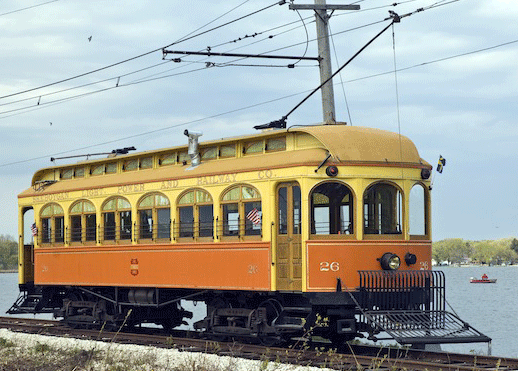
Oklahoma City station KOKH-TV reported on July 27 that Oklahoma City has unveiled the paint scheme for the six Brookville Equipment Corp. dual-mode (battery and pantograph) cars that will provide service on the city's modern streetcar line, Construction of the 4.6-mile downtown area route is scehduled to begin later this year. The streetcar liveries will be Redbud, Bermuda Green and Clear Sky Blue. The 22-stop car line is expected to begin public service by the end of 2018. The $131 million streetcar system is being funded by a one-cent sales tax approved by voters in 2009 as part of the "MAPS 3" urban revitalization program.
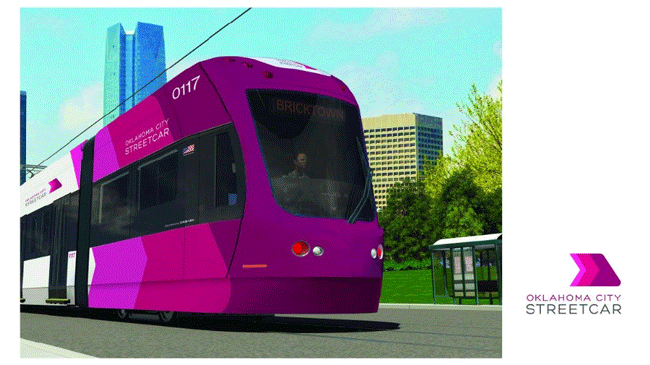
North Carolina's largest city, Charlotte, received only two bids from construction groups to extend the Uptown 1.5-mile Gold Line streetcar route on both ends to a total of four miles and both proposals were rejected in hopes of negotiating a lower price, as the Charlotte Observer reported on July 21. Both proposals were over the city's budget of $93.2 million. They came in at $123.3 from Conti and $128.5 from Balfour Beatty. The city plans to buy seven modern streetcars to operate the extended line, replacing Gomaco-built replica double truck Birneys.
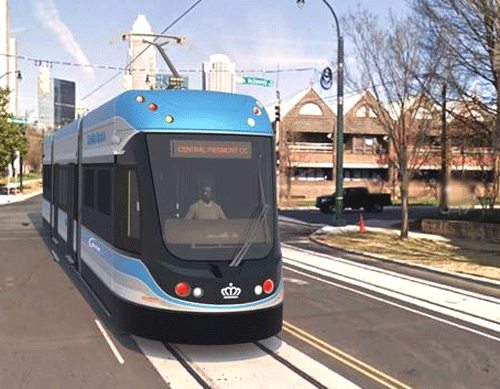
New York City has hired a "streetcar czar" to promote the proposed 16-mile Brooklyn-Queens Connector [dubbed BQX] waterfront modern streetcar line, New York Magazine reported July 15. The post went to Adam Giambrone, 39, former head of Toronto Transit Commission. Mayor Bill de Blasio is pushing the streetcar concept favored by developers and real estate interests. Giambrone, the publication said, "will have to push the project past the point of no return before the next mayor can quash it."
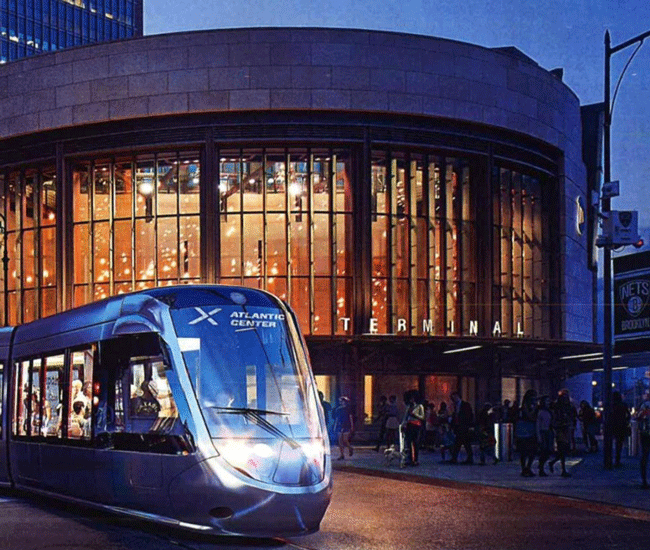
|
More Los Angeles Commuters Adapting to Light Rail!
***
Progressive Railroading reported on July 14th that the Los Angeles Country Metropolitan Transportation Authority (LACMTA) had seen dramatic increases in ridership on its Expo Line. This line from downtown Los Angeles was extended from Culver City to Santa Monica on May 20, 2016. More and more residents of the "car capital of the world" are discovering what many of us knew fifty years ago, the pleasure of not driving to work, not having to find a parking space and not having to pay large amounts for that space.
The 6.6 mile extension of the Expo Line added seven new stations at Motor Avenue, Westwood Boulevard, Sepulveda Boulevard, Bundy Avenue in Los Angeles and 26th Street/Bergamot, 17th and Colorado and 4th Street & Colorado in Santa Monica, just a short walk to the beach. This was the first rail transit to Santa Monica from Los Angeles since 1953 and it appears that the public was waiting.
Average weekday ridership on the Expo Line went from 29,047 in April 2016 to 45,876 in June, which was the first complete month of operation for the extension. However, the average Sunday ridership also leaped from 15,965 in April 2016 to 35,994 in June. The Blue Line, originally opened in 1990 from Los Angeles to Long Beach is still the heaviest line averaging over 83,400 riders daily.
As is normally the case, dramatic increases on one transit line spur increases in other lines. There were also gains on the Blue, Red, Purple and Gold lines also. The average weekday ridership on all of Metro's rail lines jumped from 333,745 in April to 362,501 in June, with half of that increase due to the Expo Line.
|
Southern California Traction Club Evolving!
***
In the summer of 2015, the Southern California Traction Club (SCTC) obtained a new member who was ten years old but extremely knowledgeable both in current and historical Southern California urban rail transit.
During the familiarization process, this youngster asked about the term "traction". Naturally we explained that the term went b back to the late 1800s when there was cable traction and electric traction. The cable cars were just abut to be installed in almost every city when the electric streetcar was developed and demonstrated. As soon as it became obvious that people were not going to get electrocuted riding the cars or crossing the tracks, most of the cable car lines vanished and within a few years, they were gone except for San Francisco.
It was soon also becoming obvious to most of the club members in the room that the term "traction" had no longer any real value so the search for a new term to possibly change the club name led the club to reconsider it's mission. It did not take long for the club to realize that the major growth in rail transportation in the last decade was in urban rail transit. This includes new light rail lines, mostly electrically powered, (but there were some diesel powered (DMU) units scattered around from New Jersey to San Diego), new modern streetcar lines from Washington D.C. to Portland, OR and Tucson, AZ and commuter trains, most of which were diesel powered.
So while in search of a revised name for the club, the club realized it needed to expand to include commuter trains as part of the total urban rail transit experience. There were lots of riders on these trains that considered the train ride a positive experience. It did not take long to conclude that N scale would be the easiest way to do this and the best way to do that would be to employ as much of the Kato UniTrack and UniTram track and equipment that could be obtained for this purpose along with Athearn N scale Bombardier Commuter cars and locomotives. So module 160, a 3' by 4' module, made from two older HO scale modules was born. Joe Delia of A-line/Proto Power West led the club some Athearn Metrolink (Los Angeles area) and Coaster (San Diego area) Bombardier Commuter cars since they were long out of production while Arnie's Mode Trains became the club source of a Metrolink (Los Angeles area) F59PHI locomotive with DCC and sound. It was so surprising to hear all that noise from something that small. Some club members could still remember when HO scale DCC decoders were around the same size of that N scale locomotive. With a goal of displaying this new module at the Great Train Show in Pomona at Pomona-Fairplex on July 30-31, 2016, the club went into hyper drive. Just a week before this show, module 160 looked as shown in the next photo with illuminated structures and street lights.
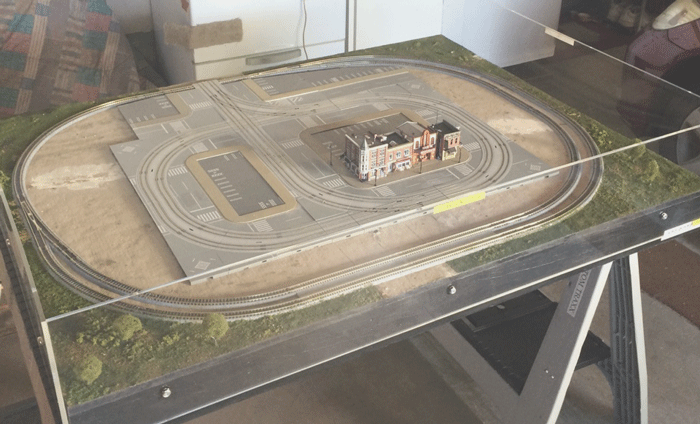
|
Meet Harriet !!
***
by AJ Staley
Los Angeles Metro has a new helper. Her name is Harriett. She works extremely hard, 60 feet underground, is 400 feet long, bores tunnels and is affectionately known as TBM (Tunnel Boring Machine). She is capable of drilling underground 5 feet at a time, stopping for a short time and installing the tunnel lining while her operators and engineers monitor her process and then she begins again.
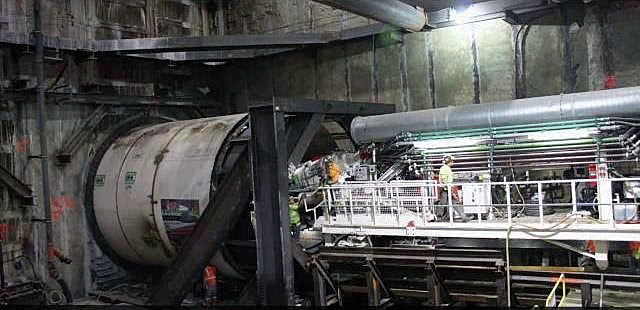
Metro started working on Harriet in the Fall of 2015. She had to be assembled and tested and the process took months.
The front section of the TBM is called the shield with a cutter head. It looks like a very large cheese grater and TBM performs two operations at the same time. As it moves or drills through the dirt, she creates a very large hole and then lines the hole with sections of concrete to form a complete ring, which will support the tunnel.
On April 27, 2016, Los Angeles county Metro set Harriet in motion starting at Crenshaw Boulevard in South Los Angeles. During Harriet’s first month of operation she completed 400 feet of tunneling, enough to completely pull her complete length into the tunnel. She will continue to bore along Crenshaw Boulevard until she gets to Vernon Street. The TBM will turn around and dig all the way back to the beginning. When she is finished she will have completed twin mile-long tunnels completely underground that will carry Light Rail Vehicles on the future Crenshaw to Los Angeles International Airport (LAX) extension.
|
A LITTLE HISTORY .............
|
Was It Really That Long Ago?
***
by Peter Ehrlich
September 3, 1993 was a red-letter day in Muni (San Francisco Municipal Railway) History. (Or should I say a "green and cream-letter day"?) On this day, the first of 17 new remanufactured PCCs for the F-Market streetcar line, which opened two years later, made a triumphant arrival into San Francisco. Here is PCC 1055 (formerly Philadelphia 2122), painted in 1955-vintage Philadelphia colors of green and cream, making the turn off... the I-280 Freeway at Geneva following its long track from Hornell, NY aboard its Silk Road Transport flatbed.
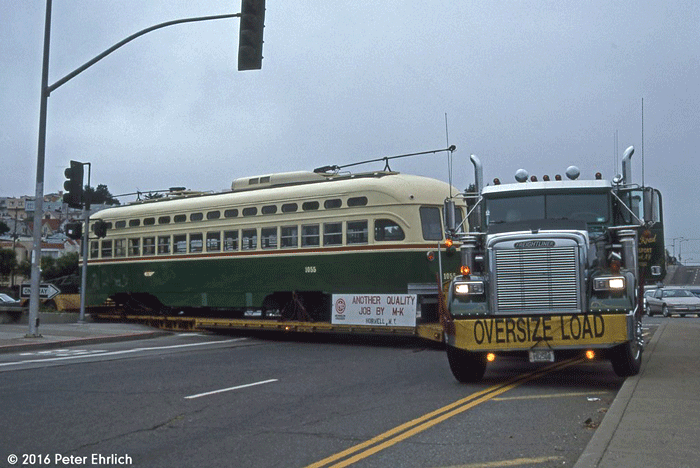
1055's livery surprised many people. The assumption at the time was that all the cars would receive the old familiar "Muni Wings" paint scheme. But, in a plan devised by some people in Muni's Planning and Community Relations Department, the idea of having the cars represent other cities in North America that ran PCCs was a stroke of genius -- one that has enlivened public transport in San Francisco and made it a much more colorful and vibrant experience. Fittingly, 1055, the first car to arrive, represented Philadelphia as most Philadelphians knew their cars. Other arriving cars would, of course, represent Baltimore, Boston, Brooklyn, Cincinnati, Chicago, Los Angeles, Louisville, Newark and others, including the "Muni Wings" paint scheme. It was left up to the Muni employees and fans to discover which would be the next arriving car. (The late Jack Smith tut-tutted when Chicago 1058 arrived, by saying, "Another green car!" but later the car was in an accident is now in a different scheme.)
Note: The above article was originally reported by Peter Ehrlich on his Facebook page during July 2016!
Ed: Car 2122 (now Muni 1055) was part of an 110 car All-Electric PCC order placed by the Philadelphia Transportation Company in July 1946 to the Saint Louis Car Co, order 1666. The cars were delivered in August and September 1948. These cars were originally ordered as two-man cars and were slated to be numbered 2801-2910, following the previous order of all-electric PCC cars, 2701-2800, most of which provided service on Route 23, Germantown Avenue. The order was changed to configure them as one/two man cars and the numbering changed to 2091-2200, in the block of numbers 2001-2500 reserved for one-man equipment. The first 50 of these 1948 cars, 2091 to 2140 were electrically equipped by Westinghouse and the latter 60, 2141 to 2200 were equipped by General Electric. Car 2122 served Philadelphia's Frankford, Belmont, Luzerne, Callowhill and Woodland depots until sold to San Francisco. Here are a few views of car 2122 during its long life:
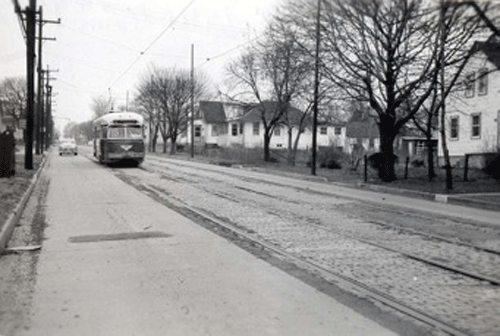
Car 2122 southbound on Rockwell Avenue, Crestmont on Route 6 in 1958.
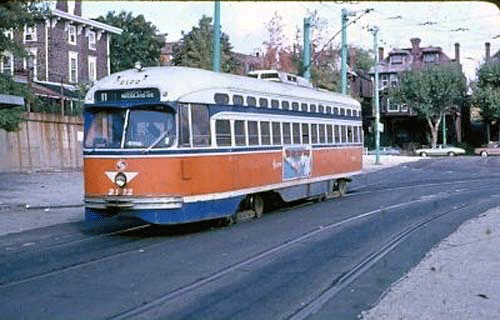
Car 2122 at 40th & Woodland Portal on Route 11 outbound in the 1970s.czr
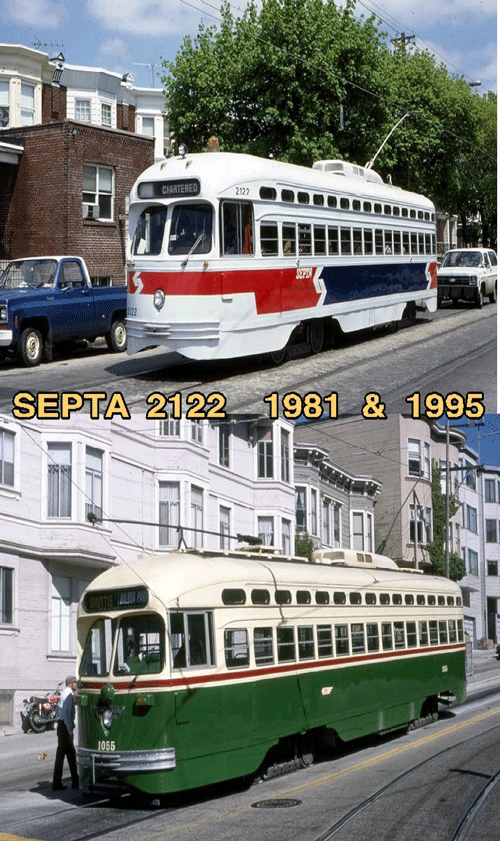
Car 2122 in 1981 along Torresdale Avenue, Route 56 in 1981 (top).
Car 2122 in 1995, now Muni 1055, on 17th Street in San Francisco (bottom).
|
COMING SOON IN THE TROLLEYVILLE TIMES!......
See how one current urban transit modeler got tired of waiting for the current crop of model railroad manufacturers to pull their heads out of you know where and offer some modern transit vehicles for today's interested riders. Coming is a detailed story on how Darrell Clarke of Pasadena, CA is fabricating his own HO scale Bowser powered model, shown below, of the 2015 KinkiSharyo LACMTA Light Rail Vehicle from stainless steel stock.
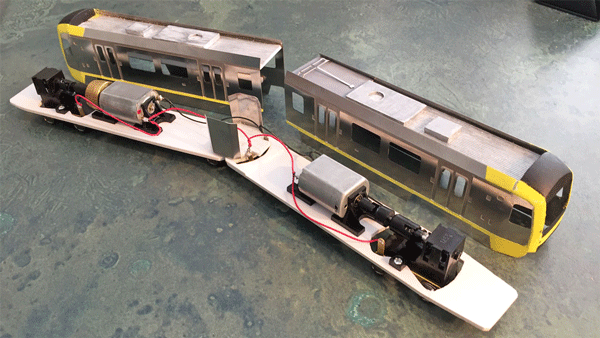
Several of these new vehicles are now in service on the Expo and Gold Lines in the Los Angeles area!
|